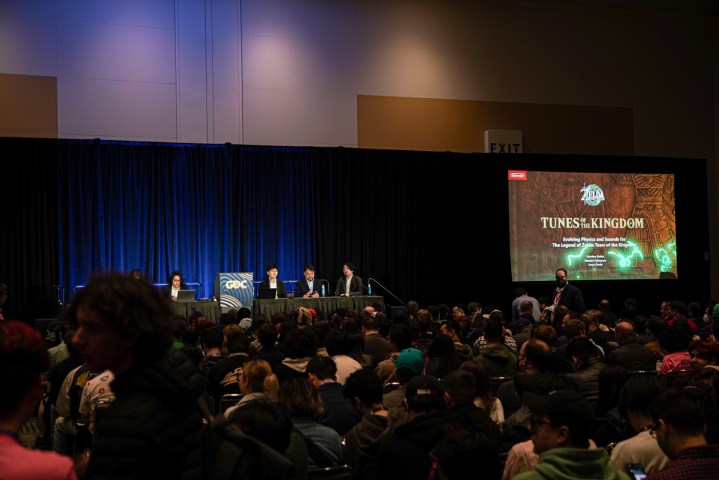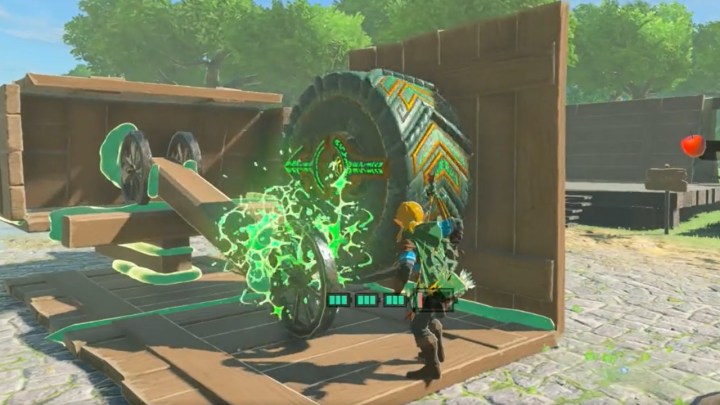
“Development is going to be chaos.”
That was the reaction of Takahiro Takayama, lead physics engineer on The Legend of Zelda: Tears of the Kingdom, when he saw the first prototypes for two of the game’s abilities: Ultrahand and Fuse. The seasoned engineer, who led the physics system on The Legend of Zelda: Breath of the Wild, as well, knew that this type of physics system was uncharted territory.
“The more I thought, the more I worried,” he explained during a panel at 2024’s Game Developers Conference (GDC). This rare peak behind the curtain from the developers at Nintendo reveals just how much of an achievement of design and engineering the unique physics system really is.
The physics of Zelda

Tears of the Kingdom has received near universal acclaim, and the physics system plays a critical role in that. It’s one of those design elements you usually take for granted — something that exists in the background and rarely comes up during core gameplay. For Tears of the Kingdom, however, physics are everything. And on a quest to deliver a true sandbox for players to let their imagination run wild, physics changed everything.
Why a physics system? For the development team behind Tears of the Kingdom, it all comes down to the concept of “multiplicative gameplay.” Instead of building fun interactions, the team set out to create systems where those interactions would happen naturally. Takuhiro Dohta, who worked on the engine behind Tears of the Kingdom, explained: “Rather than create something fun, create a system that makes fun things happen.”
That was the idea behind both Breath of the Wild and Tears of the Kingdom. Approaching the second game, the team wanted to enhance the elements the first game established. This early prototyping stage brought about Ultrahand and Fuse, which allow players to combine different elements to make something new.

It’s a great idea from a design standpoint, but the ones in charge of actually making this system work weren’t as enthused. “I knew this was going to be very, very difficult,” Takayama said.
Tears of the Kingdom uses two layers of physics. The foundation is Havok, a well-known physics system that’s widely used across games. Nintendo layers its own in-house physics system on top of this.
But those systems on their own weren’t enough. With these new abilities, the physics team broke the game on a daily basis, sending objects flying off where they shouldn’t and creating conflicts that would kill the immersive experience the team was after. “The clash between these non-physics objects and Ultrahand caused daily problems,” Takayama explained.
Originally, only some of the elements of Tears of the Kingdom had a true physics interaction. Takayama provided the example of gates and cogs as non-physics objects. These objects worked based off of their animation, and they were causing a lot of problems when interacting with the sometimes wild physics of abilities like Ultrahand.
The solution? Make everything a physics object.
A world of objects
Instead of a gate, you would have a material like wood to make up a gate, along with a motor and a chain attached to it. Together, they created something that was physically accurate. And like that, Tears of the Kingdom was cracked wide open.
“Everything, without exception, being physics-driven is necessary to make multiplicative gameplay a reality.” It got down to the core of what the team was trying to do all along. Instead of making dedicated interactions, it would need to build the systems to let players determine what interactions they wanted.

That brought about the painstaking process of simulating everything. A wheel is no longer a wheel. It’s a wheel, connected to a motor, with its own shaft and suspension. Chains are no longer just chains. They’re multiple chain links, each simulated based on their material and weight, then strung together.
You can’t do this manually for everything in the game. Takayama explained that objects would have some critical elements like mass and inertia calculated automatically based on their material, size, and shape. This made the world interact with itself. Instead of building systems for objects in the water, for example, you can calculate the buoyancy and resistance of the water and how the mass and inertia of a physics object interacts with that.
This sounds great in theory, but the team quickly ran up against an issue. There was a mismatch between how an object looked in the game and the physically qualities it would take on. Takayama provided the example of a wooden board. It needed to be much larger in order for players to see it, which meant it was much heavier and didn’t interact with the world in the way players expected.

For these situations, the team needed to adjust the objects manually. This created a carefully choreographed dance between game design, art, and physics to make objects that looked like players expected and interacted with the world like players expected. The art team needed to work with the physics team to make objects look and feel right, and everyone needed to consult with design to make sure it made sense in the game.
One of the example Takayama provided was the Portable Pot. Frightened that the content of the pot would spill out if set up on a sloped surface, the art team figured out a way to ensure the Portable Pot was always flat. It used a joint at the base of the pot to rotate it once you set the object down, ensuring it was always flat.
It’s a simple solution, but of course, it didn’t stop there. Players ended up taking the Portable Pot and using it as a joint to bring together monstrous vehicles, essentially leveraging the systems the team built to create something entirely new. That’s what makes Tears of the Kingdom so special — how players can take these physics objects and let their imagination run wild.



